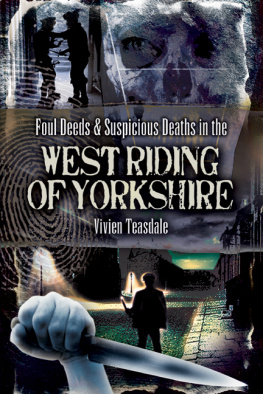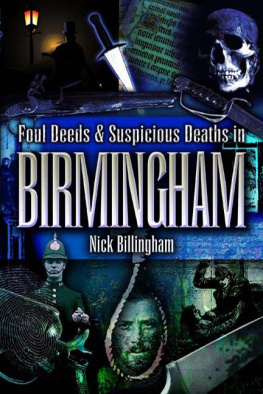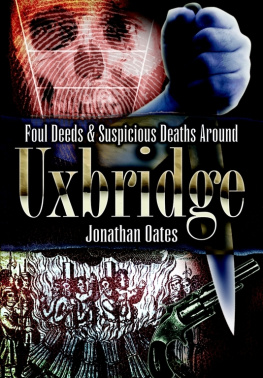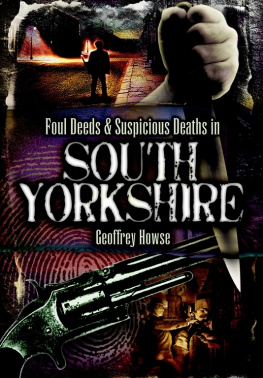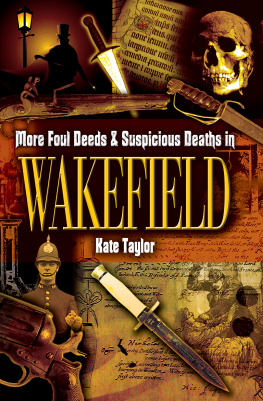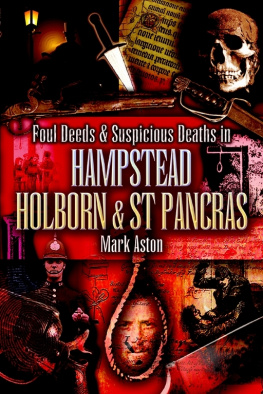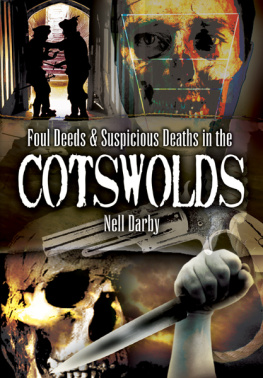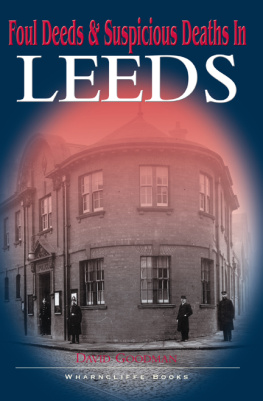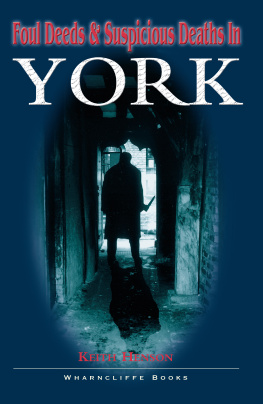
TRUE CRIME FROM WHARNCLIFFE
Foul Deeds and Suspicious Deaths Series
Barking, Dagenham & Chadwell Heath
Barnsley
Bath
Bedford
Birmingham
Black Country
Blackburn and Hyndburn
Bolton
Bradford
Brighton
Bristol
Cambridge
Carlisle
Chesterfield
Colchester
Coventry
Croydon
Derby
Dublin
Durham
Ealing
Folkstone and Dover
Grimsby
Guernsey
Guildford
Halifax
Hampstead, Holborn and St Pancras
Huddersfield
Hull
Leeds
Leicester
Lewisham and Deptford
Liverpool
London's East End
London's West End
Manchester
Mansfield
More Foul Deeds Birmingham
More Foul Deeds Chesterfield
More Foul Deeds Wakefield
Newcastle
Newport
Norfolk
Northampton
Nottingham
Oxfordshire
Pontefract and Castleford
Portsmouth
Rotherham
Scunthorpe
Southend-on-Sea
Staffordshire and The Potteries
Stratford and South Warwickshire
Tees
Warwickshire
Wigan
York
OTHER TRUE CRIME BOOKS FROM WHARNCLIFFE
A-Z of Yorkshire Murder
Black Barnsley
Brighton Crime and Vice 1800-2000
Durham Executions
Essex Murders
Executions & Hangings in Newcastle and Morpeth
Norfolk Mayhem and Murder
Norwich Murders
Strangeways Hanged
The A-Z of London Murders
Unsolved Murders in Victorian and Edwardian London
Unsolved Norfolk Murders
Unsolved Yorkshire Murders
Yorkshire's Murderous Women
Please contact us via any of the methods below for more information or a catalogue
WHARNCLIFFE BOOKS
47 Church Street - Barnsley - South Yorkshire - S70 2AS
Tel: 01226 734555 - 734222 - Fax: 01226 734438
Email: enquiries@pen-and-sword.co.uk
website: www.wharncliffebooks.co.uk


First published in Great Britain in 2009 by
Wharncliffe Local History
an imprint of
Pen & Sword Books Ltd
47 Church Street
Barnsley
South Yorkshire
S70 2AS
Copyright Vivien Teasdale 2009
ISBN 978-1-84563-095-9
eISBN 978-1-78303-768-1
The right of Vivien Teasdale to be identified as Author of this Work has been asserted by her in accordance with the Copyright, Designs and Patents Act 1988.
A CIP catalogue record for this book is available from the British Library.
All rights reserved. No part of this book may be reproduced or transmitted in any form or by any means, electronic or mechanical including photocopying, recording or by any information storage and retrieval system, without permission from the Publisher in writing.
Typeset in 11/13pt Plantin by
Mac Style, Beverley, East Yorkshire
Printed and bound in the UK by the MPG Books Group
Pen & Sword Books Ltd incorporates the imprints of Pen & Sword
Aviation, Pen & Sword Maritime, Pen & Sword Military,
Wharncliffe Local History, Pen and Sword Select, Pen and Sword
Military Classics and Leo Cooper.
For a complete list of Pen & Sword titles please contact
PEN & SWORD BOOKS LIMITED
47 Church Street, Barnsley, South Yorkshire, S70 2AS, England
E-mail: enquiries@pen-and-sword.co.uk
Website: www.pen-and-sword.co.uk
Introduction and Acknowledgements
W e all consider that the times we live in must be worse than previous times. We worry now about the number of feral children, about the increase in knife crimes, the drunkenness on our streets and wonder what causes it and what to do about it. We use name and shame to identify criminals, who once would have been put in the pillory. In the past, criminals were hanged in public on the Tyburn tree at York, now marked by a stone near the racecourse. Later the hangings became private, carried out inside the prisons. The police force was developed from its inception in 1829 in London, throughout the country, its blue uniform and blue police station lamps gradually becoming part of society.

Tybur n Stone, York. The author
Yet looking back through newspapers over the past century, the same types of stories appear time and time again. Lawlessness and threats to society were of major concern. Their causes were considered to be the availability of cheap alcohol and a lack of moral fibre on the part of the lower classes . Modern newspapers reflect these same concerns albeit expressed in less arrogant terms than the Victorian patriarchs.
The stories here cover a variety of incidents and outcomes, though the connecting themes are knives and alcohol. This was not intentional. It only became clear after I began to put all the stories together. It has been said that those who forget their history are doomed to repeat it, so perhaps now is the time for greater study of Victorian murder and mayhem . It is certainly a subject of great fascination for most people, and perhaps we can learn something from it too.

Victorian police station lamp . The author
Many thanks to the staff at many libraries and archives: Kirklees Library and Archives Services, Wakefield Library and Archives Services, Skipton Library, Leeds Library, Goole Library and Archive Service, Knaresborough Library, and Bradford Library and Archive Service for their unfailing willingness to help and offer advice on sources available.
Brian Elliott at Pen & Sword Books Limited has, as always, given invaluable assistance from initial idea to completed manuscript. My thanks also go to Bill Mathie at the School of Medicine, University of Leeds for his help in obtaining permission from the University of Leeds for the use of the Thomas Scattergood photograph on page 6 and Paul Stevenson and Richard Wade for their help in obtaining permission from the The British Postal Museum & Archive to use their photograph of a mail coach on page 151. All other photographs are from the author s collection. Maps are courtesy of the Ordnance Survey.
Family and friends have, as always, encouraged and supported me in bringing these stories to light, and I cannot thank them sufficiently.
C HAPTER 1
A Decade of Disturbances: The Yorkshire Chartists
I t is not quite a hundred years since the principle of universal suffrage became the norm in British politics. Prior to this, those with no voice in the running of the country had only one means of being heard. They rioted.
Early agitation for voting rights resulted in the Reform Act of 1832, but this had only been partially successful. The introduction of the Poor Law Amendment Act of 1834 brought greater hardship to those too ill to work and those simply unable to find a job. Poor harvests, economic downturns resulting in closure of many businesses, particularly in the north, brought many working families to the brink of starvation. It also seems to have brought about a new bout of political awareness.
By 1838 a national movement developed which became known as Chartism. It had six main aims, put together in the form of a Charter to which millions added their signature. The Chartists demands were:
Next page
